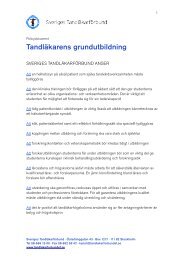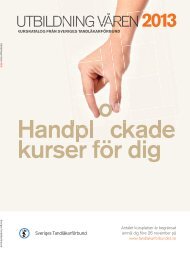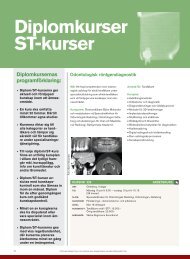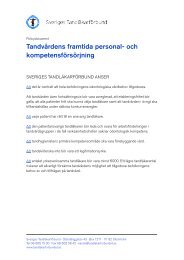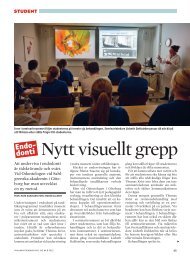Swedish Dental Journal
Swedish Dental Journal
Swedish Dental Journal
You also want an ePaper? Increase the reach of your titles
YUMPU automatically turns print PDFs into web optimized ePapers that Google loves.
eports (10, 11, 15, 23, 28, 34, 48, 49). In the present<br />
study, the pattern of tooth loss was similar to the<br />
pattern of longitudinal bone loss within the dentition.<br />
Consequently, the highest bone loss was found<br />
in maxillary molars, while mandibular canines and<br />
second premolars had the lowest periodontitis progression<br />
rate. The high tooth mortality and longitudinal<br />
bone loss for maxillary molars may be explained<br />
by several contributing factors such as furcation<br />
involvements and difficulty to remove plaque.<br />
Several studies have focused on tooth loss in periodontitis-prone<br />
individuals during the maintenance<br />
phase, while limited knowledge is available regarding<br />
the rate of longitudinal bone loss in periodontitis<br />
susceptible patients. A <strong>Swedish</strong> study (43) found<br />
that the annual mean overall longitudinal bone loss<br />
over 12 years during supportive care was 0.06 mm<br />
for a group of patients with high susceptibility to<br />
periodontal disease versus 0.02 mm for individuals<br />
with “normal” susceptibility. The longitudinal bone<br />
loss was found to be ≥0.17 mm a year for 16% of the<br />
patients in the high susceptibility group (43) compared<br />
20 % in the present study, in which the mean<br />
annual longitudinal bone loss for the whole sample<br />
was 0.09 mm. Thus, a high resemblance according<br />
to longitudinal bone loss was found for these two<br />
<strong>Swedish</strong> studies. These data are in agreement also<br />
with a study on 52 patients with mild to moderate<br />
periodontitis who reported an annual mean bone<br />
loss of 0.06 mm (8). The magnitudes of marginal<br />
bone loss during the maintenance phase were in accordance<br />
with the results from longitudinal studies<br />
performed on normal populations in Sweden (19,<br />
20, 26, 41). These longitudinal bone loss rates are in<br />
contrast to the amount of disease progression reported<br />
by Lindhe & Nyman (30), who found unchanged<br />
bone scores in patients with advanced periodontitis<br />
during a maintenance period over 14 years with a<br />
well-supervised care program, and in another study<br />
on 155 compliant patients an annual bone gain of<br />
0.02 mm was found after a maintenance phase of 7<br />
years (22). An American study (27) reported an annual<br />
bone loss of 0.04 mm for periodontitis patients<br />
maintained for 10 years in a dental school in North<br />
Carolina. These magnitudes of longitudinal bone<br />
loss were in agreement with the results from studies<br />
on “normal” populations with regular dental care<br />
habits reporting mean annual marginal bone losses<br />
of 0.02-0.04 mm (39, 47).<br />
The results of the stepwise regression analyses,<br />
using the longitudinal tooth loss as the dependent<br />
jansson, lagervall<br />
variable, showed that smoking was the only variable<br />
significantly correlated to an increased longitudinal<br />
tooth loss. Several earlier studies have adopted linear<br />
multiple regression analyses or logistic regression<br />
analyses in order to investigate potential predictors<br />
of longitudinal tooth loss during maintenance care<br />
10, 15, 28). In these studies smoking was found to be<br />
one of the most important risk predictors of tooth<br />
loss in agreement with the results of the present<br />
study. However, smoking was not found to be a risk<br />
factor of longitudinal bone loss in accordance with<br />
another study on patients during maintenance phase<br />
(40) but in contrast to several cohort or follow-up<br />
studies (6, 7, 21, 36), which have included smoking<br />
as an independent variable in regression analyses investigating<br />
the periodontitis progression and these<br />
studies showed a strongly significant association<br />
between smoking and longitudinal bone loss. The<br />
limited size of the sample in the present study as well<br />
as few individuals who were non-smokers could explain<br />
the non-significant influence of smoking on<br />
bone loss. In addition, it cannot be excluded that<br />
teeth lost at the re-evaluation had a more diseased<br />
state compared to remaining teeth which may underestimate<br />
the longitudinal bone loss in smokers who<br />
lost significantly more teeth than non-smokers (6).<br />
The number of periodontal pockets ≥6 mm at baseline<br />
was significantly correlated to the number of<br />
periodontal pockets ≥6 mm at the first and last reevaluations<br />
and the regression analysis showed a significant<br />
correlation to an increased longitudinal bone<br />
loss. A high prevalence of residual pockets has been<br />
associated with an increased risk for periodontitis<br />
progression (4, 12). In a longitudinal epidemiological<br />
study over 15-18 years using a logistic regression<br />
model (36), deepened pockets ≥6 mm at baseline<br />
were found to be significantly correlated to severe periodontitis<br />
progression. Consequently, several studies<br />
support the hypothesis that deepened periodontal<br />
pockets constitute a risk predictor of further longitudinal<br />
bone loss even if deep pocket may be stable over<br />
several years during a maintenance phase (25).<br />
In conclusion, for a group of periodontitis-prone<br />
subjects with a great majority of smokers, the magnitudes<br />
of marginal bone loss and tooth loss during<br />
a maintenance phase of 10-26 years were in accordance<br />
with the results from longitudinal studies<br />
performed on normal populations in Sweden. This<br />
emphasizes the importance of compliance and regular<br />
supportive care with an adequate plaque control<br />
in order to prevent periodontitis progression.<br />
112 swedish dental journal vol. 32 issue 3 2008




